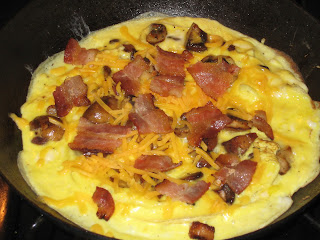 |
| with a dollop of herbed goat cheese on top |
Omelets are my go-to weekend brunch item. Having people over? Made to order omelets. It's kind of my thing. So being a self-proclaimed omelet aficionado I have found there tend to be 2 schools of omeleteers - the insiders and the mix-ins. I myself am a mix-in.
The insiders prepare the eggs to doneness, add the fillings at the very end and fold over. Perhaps this is what you traditionally envision an omelet to be. I, however, have found the taste to be much more appealing when the flavors get a chance to infuse with the egg. Ingredients that I want to have cooked, such as mushrooms, onions, meat, etc., cook in the pan and the eggs are added to the ingredients. That way the mix-ins are combined with the egg, ensuring that each bite has a little something different. I'll put cheese strictly in the middle, and certainly am not averse to throwing more mix-ins/toppings into the center of the omelet, but I like my eggs to also have some surprises lurking within. You may think of this as more of a scramble, but since the omelet ends up folded over and the egg is a single entity, I call it an omelet.
I digress. A very important first step to any good omelet is the preparation of the eggs. I typically make 2-egg omelets. Crack your eggs into a small mixing bowl and add milk. About 1-2 tbsps should do for 2 eggs. I eyeball it. Add some salt and pepper and stir.
You want to make sure you have a nice homogenous mixture of yolk, white, and milk, but don't go overbeating. If you want to add any dried or fresh herbs to your eggs, this is the stage I like to add them as well.
Next, cook whatever fillings you will be using in a nice omelet-sized skillet. Nonstick is great for a nicer looking omelet. My pan is old and not very omelet friendly, but it's the perfect size! As should be expected by now, I typically start by cooking the bacon. Once done, I remove to paper towels, but then I use the bacon grease to saute my veggies. If you are averse to bacon, or perhaps want something feigning healthiness, use butter.
Once your veggies are sauteed to your likeness, add your scrambled egg/milk mixture. You'll get a nice even coating of the pan and hopefully there will be a nice distribution of your veggies.
 |
| this omelet appears to contain onions and tomatoes |
I used to think a good omelet was one whose integrity was never disturbed following the addition of the eggs to the pan. It would often take awhile to cook through entirely, but I didn't want to disturb the beautiful flat egg pancake I had created. I often covered the pan with a lid to help cook, but this was getting tedious. I then learned that omelets actually taste exactly the same even if they're roughed up a little around the edges. Using a nonstick, heatproof spatula, it's ok to push the cooked egg at the edges into the center and allow the still uncooked egg to ooze into this previously occupied space. Sure you get a lumpy omelet in some places, but your egg cooks evenly and quickly.
 |
| this omelet has onions, mushrooms, bacon, and cheese |
Once the omelet is about 90% done, add your center toppings. For me this will include the bacon and most definitely the cheese. I can't have an omelet without cheese. Scallions or chives are good at this point. Avocados and tomatoes are also crowd favorites.
Finally, it's time to slide the omelet out of the skillet and fold it over on the plate. You can fold it in the skillet if you'd like, but i've always been one to slide it off the pan half way and with a flip of the wrist let the top half fold over. The lower your heat, slicker your pan, and shorter your cooking time, the less brown the finished outside of the omelet is. And worst case scenario, if you mess up an omelet, you have a delicious scramble, still a meal that will certainly impress your guests when they've just woken up.

No comments:
Post a Comment